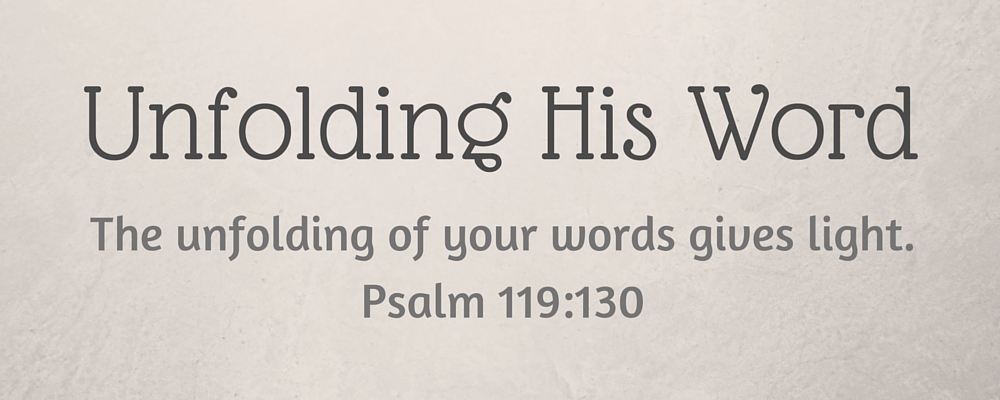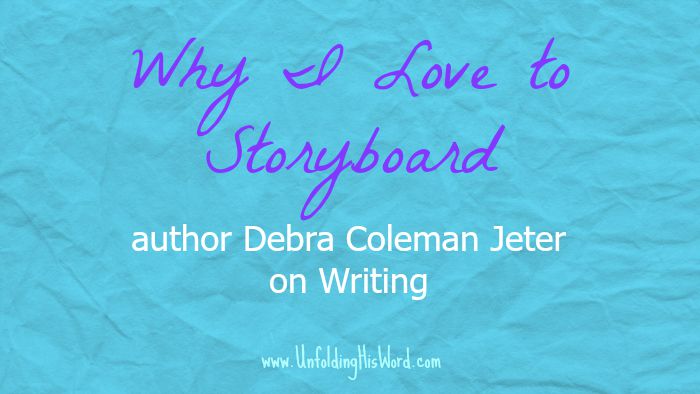My guest on Unfolding His Word today is Debra Coleman Jeter, award-winning writer and author of the new novel, The Ticket. Whether you write fiction or non-fiction, you’ll find ideas here to keep you writing. Please join me in welcoming Debra on writing:
I used to write in spurts, and I’d be untruthful if I claimed to be completely changed in this regard. But I have discovered a technique that helps keep me on task, even during those draggy days when I don’t feel remotely inspired.
Every day I try to write, at a minimum, either: 3 storyboards or one scene. The storyboard can take a lot of different forms. The one I use consists of:
- Brief overview of scene
- Time/place
- Season/weather
- Senses: sound, smell, etc
- Images
- Relationships of characters appearing in scene
- Dialogue (I scribble a few lines here and sometimes the scene takes off at this point)
- Subtext
- Actions
- Point of view
- Climax
- Final image and/or last line
I print out several copies of my storyboard headings (followed by a couple of blank lines after each), and I may stare at one for some time before I write a thing. Eventually, though, I begin to fill in the blanks. I tell myself it doesn’t matter what I write as it is just a storyboard. Often I get going and turn the page over to scribble more ideas for the scene on the back.The following day I select one of the storyboards and instruct myself to write at least five pages. Since I’ve already put a fair amount of thought into it the day before—I have my storyboard in front of me—the scene often seems to write itself once I get going.
I don’t always fill in every blank on my storyboard. I often scribble other ideas that don’t really fit the storyboard. For instance, if an idea for the opening line comes to me, I jot that down. If this line leads to a complete paragraph, even better! In some ways writing a storyboard is like writing a story. I let the words take me where they want to go. The main purpose of the framework is simply to get myself thinking and get my pen moving. Some writers may not need this tool, but I’ve found that it helps me immeasurably.
For some works—whether short or long—I use outlines but not always. When I do, the outline may be very detailed or quite brief. Some storylines seem to lend themselves better to outlining while others take more of a free form path in my mind and on paper. Yet somehow I keep coming back to storyboarding, regardless of whether I’m working with or without an outline.
I don’t always heed the words on the storyboard, however. Sometimes I find that I’ve written an entire scene without reference to any of the senses. When this happens, I usually push forward if I’m working on a first draft. Later, in the editing process, I may come back to take a second look at the storyboard for a scene to see what I had in mind. I even use a code on occasion for each page of the manuscript, some variation of the things I need to keep in mind as I edit. For example, I may use A for actions, I for imagery, AV for active verb, V for visuals, SM for smells, SO for sounds, etc. Of course I don’t need all of these on every page, but it helps me avoid going for long stretches without actions or sensory details. I don’t want my writing to drag and bore my readers. Glancing back over what I’ve just written, I may be at risk of boring you so I’ll stop!
Never, never give up—and happy storyboarding!
So, non-fiction writers, how can you use this technique to keep your writing moving along?
About the Author
 A Vanderbilt University professor, Debra Coleman Jeter has published fiction and nonfiction in popular magazines, including Working Woman, New Woman, Self, Home Life, Savvy, Christian Woman, and American Baby. Her story, “Recovery,” won first prize in a Christian Woman short story competition, and her nonfiction book “Pshaw, It’s Me Grandson”: Tales of a Young Actor was a finalist in the 2007 USA Book News Awards. She is a co-writer of the screenplay for Jess + Moss, a feature film which premiered in 2011 at the Sundance Film Festival, and captured several international awards. She lives in Clarksville, Tennessee, with her husband. Connect with her at www.debracolemanjeter.com.
A Vanderbilt University professor, Debra Coleman Jeter has published fiction and nonfiction in popular magazines, including Working Woman, New Woman, Self, Home Life, Savvy, Christian Woman, and American Baby. Her story, “Recovery,” won first prize in a Christian Woman short story competition, and her nonfiction book “Pshaw, It’s Me Grandson”: Tales of a Young Actor was a finalist in the 2007 USA Book News Awards. She is a co-writer of the screenplay for Jess + Moss, a feature film which premiered in 2011 at the Sundance Film Festival, and captured several international awards. She lives in Clarksville, Tennessee, with her husband. Connect with her at www.debracolemanjeter.com.
Her debut novel, The Ticket, is now available through Amazon, Barnes & Noble, and other outlets. Check out the book trailer at: https://vimeo.com/50187275


Nivine,
Thank you so much for hosting me today. I love your website, by the way! I leave tomorrow for a tour of the Maritime Provinces. I’ll get to visit the home of one of my favorite authors, Lucy Maud Montgomery (who wrote the Anne of Green Gables books, among others). In case I get comments while I’m gone, I’m not sure whether I’ll be able to access internet, but I will definitely check when I can. Thanks again!
Great to have you on the site, Debra. I hope you have a great time!
Great article, Debra! I am such a pantster, but your ideas sound great! I may have to try it!